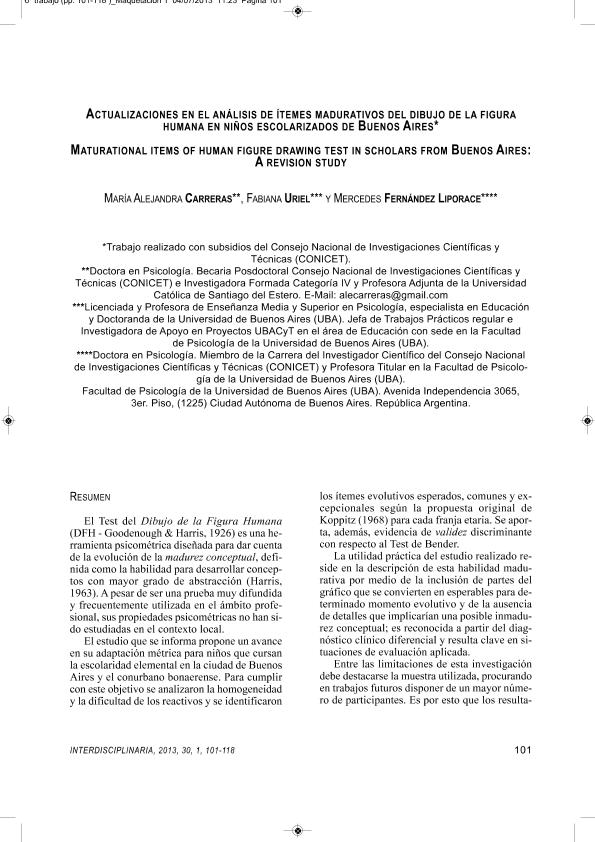Artículo
El Test del Dibujo de la Figura Humana (DFH - Goodenough & Harris, 1926) es una herramienta psicométrica diseñada para dar cuenta de la evolución de la madurez conceptual, definida como la habilidad para desarrollar conceptos con mayor grado de abstracción (Harris, 1963). A pesar de ser una prueba muy difundida y frecuentemente utilizada en el ámbito profesional, sus propiedades psicométricas no han sido estudiadas en el contexto local. El estudio que se informa propone un avance en su adaptación métrica para niños que cursan la escolaridad elemental en la ciudad de Buenos Aires y el conurbano bonaerense. Para cumplir con este objetivo se analizaron la homogeneidad y la dificultad de los reactivos y se identificaron los ítemes evolutivos esperados, comunes y excepcionales según la propuesta original de Koppitz (1968) para cada franja etaria. Se aporta, además, evidencia de validez discriminante con respecto al Test de Bender. La utilidad práctica del estudio realizado reside en la descripción de esta habilidad madurativa por medio de la inclusión de partes del gráfico que se convierten en esperables para determinado momento evolutivo y de la ausencia de detalles que implicarían una posible inmadurez conceptual; es reconocida a partir del diagnóstico clínico diferencial y resulta clave en situaciones de evaluación aplicada. Entre las limitaciones de esta investigación debe destacarse la muestra utilizada, procurando en trabajos futuros disponer de un mayor número de participantes. Es por esto que los resultados deben considerarse como tendencias cuya generalización deberá analizarse en nuevos estudios y también mediante la introducción de nuevas líneas de discusión. The Human Figure Drawing Test (HFD -Goodenough & Harris, 1926) is a psychometric scale developed to measure individual evolution of conceptual maturity in children of school age. This concept is described as the ability to develop concepts with an increasing degree of abstraction (Harris, 1963). In despite of being a widely applied test in professional contexts, its psychometric properties were not properly analyzed in local populations. This paper proposes an advance on its metrical adaptation, in order to be used in scholars from Buenos Aires and its suburbs. To reach this research goal, item homogeneity and difficulty indexes were calculated. Following original Koppitz's proposals (1968), expected developmental items were identified, as well as the common and exceptional ones in each age interval considered. Discriminate validity evidences regarded to Bender's Gestalt Scale were also analyzed. Considering children's age, common parts composing the human figure were identified, meaning that 85% per cent (and more) of the children in a given age included that part as an important detail in the drawing. This way, it became an expectable item for that age interval. Unusual elements were also identified (15% of the cases or less) in protocols of each analyzed group. This analysis showed that some parts were omitted for the majority of children in the studied sample. The applied utility of this particular analysis consists in the identification of items which would be present in drawings produced by children without problems in each age level in local population, when a normative criterion is followed in the individual assessment. The importance of an item omission when it is expected must be highlighted, because of its importance as a relevant indicator of potential problems. The contribution here intended consists in the description of this maturational ability using parts of the drawing which become expectable in a given developmental age. The absence of certain details may imply conceptual immaturity; these two kinds of indicators are characterized in the differential diagnosis and are key signs in applied assessment situations. Concerning discriminate validity evidences, a significant average and positive association between scores of conceptual maturity (HDF) and visual-motor ability (Bender's) was verified in the whole simple. Associations became lower if the simple was spitted by age. Developmental motorist and perceptual aspects appear to converge with conceptual abilities measured in the sample, existing an overlapping of both of them in the activities involved, although not lower enough to speak about abilities related but about abilities of a different nature. Despite both scales (HFD and Bender's) demand a graphic action to be responded, they intend to assess theoretical concepts hypothetically differentiated. Otherwise, empirical verifications seem to speak about a significant relationship between them. Analyzing the association between these abilities through an increasing curve of age during childhood allows to infer a decrease in values of Pearson coefficients as chronological age increases (.259*; .234**; .474**, .179*, .283**, .189*, and .251). Such results can be interpreted as a gradual discrimination between perceptual, motorist and conceptual abilities, when developmental level shows an ascendant peak. One of the limitations of this research lies in the sample employed, which involved a restricted number of participants across each age included. Future developments must improve this issue, in order to challenge these findings. For this reason these results must be analyzed as preliminary tendencies. Their potential intention of generalization should be tested in future studies, and also by means of the generation of new research lines. These advances are disposable to be tested in new populations, and they intent to become a contribution for applied practice of psychological assessment with children.
Actualizaciones en el análisis de ítemes madurativos del Dibujo de la Figura Humana en niños escolarizados de Buenos Aires
Título:
Maturational items of Human Figure Drawing test in scholars from Buenos Aires: A revision study
Fecha de publicación:
01/2013
Editorial:
Centro Interamericano de Investigaciones Psicológicas y Ciencias Afines
Revista:
Interdisciplinaria
ISSN:
0325-8203
e-ISSN:
1668-7027
Idioma:
Español
Tipo de recurso:
Artículo publicado
Clasificación temática:
Resumen
Archivos asociados
Licencia
Identificadores
Colecciones
Articulos(SEDE CENTRAL)
Articulos de SEDE CENTRAL
Articulos de SEDE CENTRAL
Citación
Carreras, María Alejandra; Uriel, Fabiana Edith; Fernandez Liporace, Maria Mercedes; Actualizaciones en el análisis de ítemes madurativos del Dibujo de la Figura Humana en niños escolarizados de Buenos Aires; Centro Interamericano de Investigaciones Psicológicas y Ciencias Afines; Interdisciplinaria; 30; 1; 1-2013; 101-118
Compartir




